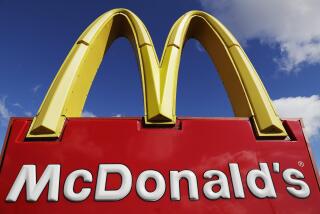Pizza Maker Reaches for Its Slice
- Share via
With a pizza parlor seemingly on every other corner, what Southern Californians didn’t appear to need was another chain peddling its pies. But with the recent arrival of Papa John’s International Inc., the pizza wars are again heating up.
The rapid growth of Papa John’s, which has expanded to 1,800 locations since its founding in 1984, is fueled by a simple bit of arithmetic. Whether it’s thick crust or thin, pizza is a $21.1-billion-and-growing business. And newcomer Papa John’s, which now has about 40 stores in Southern California, is rapidly expanding in an industry where most of the good corners would seem to have been taken.
Papa John’s founder and Chairman John Schnatter has ignored Pizza Hut’s strategy of offering consumers sit-down dining. He steered clear of price cutting that Little Caesars used to build share. Schnatter also tweaked Domino’s home-delivery scheme by placing a heavier emphasis on product quality rather than simple delivery speed.
And, when it began its first national television advertisements in 1997, the Louisville, Ky.-based chain picked a fight with market leader Pizza Hut about whose pizzas are fresher. Irate Pizza Hut executives responded with a federal court lawsuit alleging fraudulent and deceptive advertising.
New Pizza Chain Is Stirring Things Up
Papa John’s also tweaked Pizza Hut with other ads showcasing a prominent franchisee--Pizza Hut founder Frank Carney, who now operates 70 Papa John’s storefronts. A round of the Carney ads aired nationally during the telecast of the recent World Series games.
Papa John’s is stirring things up at a time when the pizza business is in flux.
* Pizza Hut, long a ward of soft drink giant PepsiCo Inc. has been spun off along with sister chains Taco Bell and KFC as Tricon Global Restaurants. Dallas-based Pizza Hut is shedding unprofitable stores, spending freely on new menu items and experimenting with a stock option plan to keep valuable restaurant-level managers from jumping ship.
* Domino’s, the second-largest pizza chain, floundered during the mid-1990s as guiding force Tom Monaghan took his eye off of the business he founded in 1960. Monaghan succeeded in restoring the company’s bottom line and then agreed to sell most of his stake in the Ann Arbor, Mich.-based chain to New York-based Bain Capital Inc. for a reported $1 billion.
* Little Caesars, the privately held company that practically invented two-for-one pizzas, is struggling to regain momentum at a time when consumers seem to be more interested in how pizza tastes rather than how little it costs. The Farmington Hills, Mich.-based company has dropped its longtime advertising agency and directed its new agency to focus more on its menu.
* Even though pizza lovers have 58,393 pizzerias to choose from, newcomers are scrambling to build more. Dallas-based Pizza Inn, for example, has built 500 storefronts with sit-down dining.
And, unlike the burger wars, in which the five biggest chains control more than 80% of the market, the big operators can’t ignore small, independent pizzerias that cook about half of the 3 billion pizzas sold nationwide each year.
Papa John’s remains squarely in the shadow cast by market leader Pizza Hut, with 7,200 storefronts. But Papa John’s has stunned the industry by managing a near-double digit growth rate in an industry that’s growing at just a 3.2% clip.
The chain’s locations are little more than kitchens with parking lots for delivery vehicles, so franchisees opt for less-costly real estate that’s not always visible from busy roads.
The menu is simple--regular and thin crust pizzas. Seventy percent of Papa John’s business is delivery; customer pick-ups account for the rest. And, because there’s no sit-down dining, Coca-Cola Co. soft drinks are sold in bottles and cans.
Fast-food franchising industry veteran Wayne Gaunce says he became a franchisee after sending his son to pick up some pies at the nearest Papa John’s, which was nearly 100 miles away.
When office workers devoured the hours-old pies, Gaunce, a Glasgow, Ky., businessman, signed on. “It’s still hard to believe we’ve grown like we have,” said Gaunce, whose company now runs 74 Papa John’s.
Restaurant Ads Go Against the Grain
Papa John’s advertising goes against the grain in an industry in which ads typically pound away at new dishes such as Pizza Hut’s Edge, service improvements such as Domino’s HeatZone delivery system and value-oriented campaigns such as Little Caesars promise of more pizza for your money.
Restaurant industry analysts say the reliance on new products works when a chain has something to shout about but echoes aimlessly when there’s no big hit on the menu.
Papa John’s ads, produced by Atlanta-based Fricks/Firestone, tout quality, and they’ve generated a flurry of protests.
Domino’s and Pizza Hut both have petitioned the National Advertising Division of the Council of Better Business Bureaus to determine whether Papa John’s should amend its ads. The chains argued unsuccessfully that Papa John’s was pitching its pies as fresher--while implying that competitors used days-old dough and canned tomatoes.
Pizza Hut’s lawsuit takes aim at commercials that show Papa John’s tomatoes being plucked from the vine--while a Pizza Hut employee spooned tomato paste from a can.
The food fight didn’t stop there. Papa John’s fired back with a “David vs. Goliath” advertisement in newspapers, and Schnatter demanded that Pizza Hut pay Papa John’s legal fees for the “frivolous” suit.
Pizza Hut countered by providing media outlets with videotape of an aging plant in New York where some Papa John’s ingredients are shipped from, along with footage showing that some Papa John’s locations used canned rather than fresh mushrooms.
As reporters began writing about the aggressive newcomer’s gains, Pizza Hut executives grumbled that the media were painting a simplistic picture of Papa John’s eating Pizza Hut’s lunch. “That’s a nice angle and it makes for nice headlines, but it’s not true,” said Randy Gier, Pizza Hut’s chief marketing officer. “Pizza Hut is having one of the most successful years we’ve had in years. We’ve put our business back on track.”
Pizza Hut executives argue that long-term success is driven by how well existing stores do--not by how fast a company adds new locations. And, observers say, the restaurant industry is littered with fast-growing concepts--most recently, Boston Market--that ran out of gas after an initial sprint.
But some fast-food veterans are welcoming Papa John’s message.
Pizza Hut founder Carney steered clear of the industry after selling his Pizza Hut holdings to PepsiCo in 1977. But Carney has opened 70 locations since joining Papa John’s in 1994 and, as Papa John’s commercials show, he’s sold on the chain’s future.
Papa John’s also has clicked with franchisees like Pasadena businessman Wally Noel, who sold his 250 Pizza Hut restaurants to PepsiCo in 1990. In recent months, he opened four Papa John’s storefronts in Greater Los Angeles.
“Pizza Hut is a good company, don’t get me wrong,” said Noel, whose firm plans to open 100 storefronts in a territory that stretches from Hollywood to the Nevada line. “But Papa John’s is a better company.”
Papa John’s shares closed up $2.44 at $38.63 in Nasdaq trading Wednesday, one day after the company announced that third-quarter net income rose by 40% to $9.6 million on revenue that rose by 30% to $166.4 million.
(BEGIN TEXT OF INFOBOX / INFOGRAPHIC)
Topping the Market
The Big Four pizza companies account for about half of the pizzas sold in the U.S. Advertising expenditures tend to rise when a chain is expanding rapidly or has a hot new product--and fall when the menu is unchanged.
National Ad Totals for Top Pizza Chains
In millions of dollars
Pizza Hut
January-July, 1997: $95.9
January-July, 1998: $73.9
*
Domino’s
January-July, 1997: $65.3
January-July, 1998: $68.0
*
Little Caesars
January-July, 1997: $23.4
January-July, 1998: $24.2
*
Papa John’s
January-July, 1997: $9.3
January-July, 1998: $12.4
Source: Competitive Media Reporting and Publishers Information Bureau
More to Read
Eat your way across L.A.
Get our weekly Tasting Notes newsletter for reviews, news and more.
You may occasionally receive promotional content from the Los Angeles Times.










